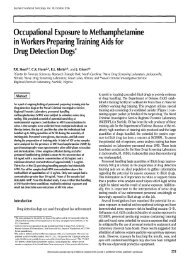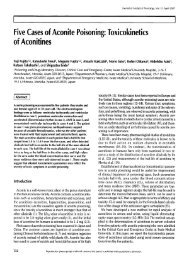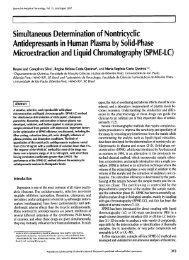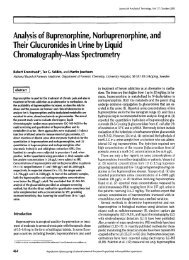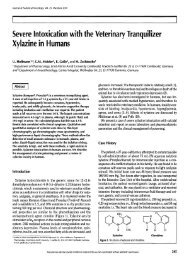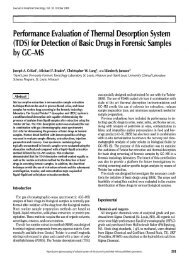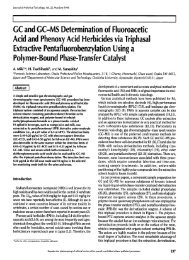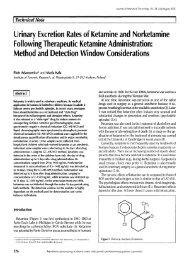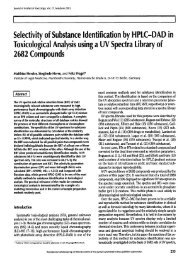Disposition of Hydrocodone in Hair - Journal of Analytical Toxicology
Disposition of Hydrocodone in Hair - Journal of Analytical Toxicology
Disposition of Hydrocodone in Hair - Journal of Analytical Toxicology
You also want an ePaper? Increase the reach of your titles
YUMPU automatically turns print PDFs into web optimized ePapers that Google loves.
<strong>Journal</strong> <strong>of</strong> <strong>Analytical</strong> <strong>Toxicology</strong>, Vol. 30, July/August 2006<br />
<strong>Disposition</strong> <strong>of</strong> <strong>Hydrocodone</strong> <strong>in</strong> <strong>Hair</strong><br />
Christ<strong>in</strong>e Moore'>, Michael Feldman-, Edward Harrison>, Sumandeep Rana', Cynthia Coulter', David Kuntz-,<br />
Alpana Agrawal', Michael V<strong>in</strong>cent', and James Soares'<br />
llmmunalysis Corporation, 829 Towne Center Drive, Pomona, California 91767 and2LabOne, Salt Lake City, Hayes Build<strong>in</strong>g,<br />
Unit C, 2282 South Presidents Drive, West Valley City, Utah 84120<br />
I Abstract I<br />
Theuse <strong>of</strong> prescription drugs, <strong>in</strong>clud<strong>in</strong>g syntheticopiates,is<br />
<strong>in</strong>creas<strong>in</strong>g <strong>in</strong> the U.S., withemergency room reports show<strong>in</strong>g a<br />
dramatic rise <strong>in</strong> prescription opiate abuse. As part <strong>of</strong> an ongo<strong>in</strong>g<br />
study, the hair <strong>of</strong> admitted opiate users wasanalyzed for<br />
hydrocodone and hydromorphone, as wellas code<strong>in</strong>e,morph<strong>in</strong>e,<br />
and 6-acetylmorph<strong>in</strong>e <strong>in</strong> order to determ<strong>in</strong>eifthere wasany<br />
correlationbetweenself-reported frequency <strong>of</strong> opiate <strong>in</strong>takeand<br />
the concentration <strong>of</strong> drug detected <strong>in</strong> hair. Thehairswere<br />
confirmed us<strong>in</strong>g gaschromatography-mass spectrometry follow<strong>in</strong>g<br />
screen<strong>in</strong>g byenzymel<strong>in</strong>ked immunosorbent assay(ELISA).<br />
Twenty-four hair specimens collectedfrom volunteers showed the<br />
presence <strong>of</strong> hydrocodone (130-15,933 pg/mg); four <strong>of</strong> those also<br />
conta<strong>in</strong>ed hydromorphone (59-504 pg/mg). Thespecimens were<br />
alsoanalyzed for morph<strong>in</strong>e, code<strong>in</strong>e,and 6-acetylmorph<strong>in</strong>e. <strong>Hair</strong><br />
specimens from five self-reported code<strong>in</strong>eusersshowed<br />
concentrations <strong>of</strong> hydrocodone between592 and 15,933 pg/mg.<br />
Inaddition,code<strong>in</strong>ewas presentat concentrations <strong>of</strong> 575-20,543<br />
pg/mg, but neither morph<strong>in</strong>e nor hydromorphone were present <strong>in</strong><br />
any <strong>of</strong> those hair specimens. Though the analysis <strong>of</strong> someopiates<br />
<strong>in</strong> hair has been previously published, this is the firststudywhere<br />
the hydrocodone and hydromorphone concentrations have been<br />
measured follow<strong>in</strong>g self-reported opiate <strong>in</strong>take.<br />
Introduction<br />
Prescription opioids such as Vicod<strong>in</strong>'", Lortab" (hydrocodone),<br />
and Dilaudid'? (hydromorphone) are becom<strong>in</strong>g <strong>in</strong>creas<strong>in</strong>gly<br />
abused <strong>in</strong> the U.S. Data from the 2003 Drug Abuse<br />
Warn<strong>in</strong>g Network, which collects <strong>in</strong>formation on drug-related<br />
episodes from hospital emergency departments <strong>in</strong> metropolitan<br />
areas, aswell as from Medical Exam<strong>in</strong>er <strong>of</strong>fices, listed opiates<br />
or opioids as present <strong>in</strong> 20,830 cases <strong>of</strong>emergency room (ER)<br />
visits because <strong>of</strong>overmedication. Non-medical use<strong>of</strong> opioids<br />
accounted for 17% <strong>of</strong>ER visits. Various surveys <strong>in</strong>dicate an <strong>in</strong>crease<br />
<strong>in</strong> the use <strong>of</strong> prescription opiates, with hydrocodone<br />
be<strong>in</strong>g among the drugs show<strong>in</strong>g the mostpronounced trends<br />
<strong>of</strong><strong>in</strong>creas<strong>in</strong>g abuse (1). In a recent study <strong>of</strong>prescription drug<br />
* Author to whom correspondence should be addressed. E-mail cmoore@immunalysis.com.<br />
abuse <strong>in</strong> Miami, 36% <strong>of</strong> ecstasy users also reported hydrocodone<br />
use (2).<br />
Procedures for the detection <strong>of</strong> these drugs <strong>in</strong> ur<strong>in</strong>e have<br />
been published (3,4) and there are several publications regard<strong>in</strong>g<br />
the <strong>in</strong>corporation <strong>of</strong>opiates <strong>in</strong>tohair (5,6), <strong>in</strong>clud<strong>in</strong>g<br />
studies employ<strong>in</strong>g the analysis <strong>of</strong>hair to prove hero<strong>in</strong> <strong>in</strong>take<br />
and/or dist<strong>in</strong>guish hero<strong>in</strong> use from morph<strong>in</strong>e or code<strong>in</strong>e <strong>in</strong>gestion<br />
(7,8). As far back as 1994, Nakahara etal. (9) described<br />
the importance <strong>of</strong>the efficient extraction <strong>of</strong>opiates from hair,<br />
compar<strong>in</strong>g five extraction methods. Other procedures for the<br />
determ<strong>in</strong>ation <strong>of</strong>drugs used <strong>in</strong> the treatment<strong>of</strong>hero<strong>in</strong> addiction,<br />
such as methadone (10), l-a-acetylmethadol (11), and<br />
buprenorph<strong>in</strong>e (12), <strong>in</strong> hairhave also been reported. However,<br />
we found only one publication specifically describ<strong>in</strong>g the detection<br />
<strong>of</strong> hydrocodone and hydromorphone, as well as oxymorphone<br />
and oxycodone simultaneously <strong>in</strong>human hairus<strong>in</strong>g<br />
gas chromatography-mass spectrometry (GC-MS) (13). The<br />
paper describes the methodology <strong>of</strong>analysis, but has noresults<br />
from the analysis <strong>of</strong> samples where drug <strong>in</strong>take history was<br />
available.<br />
Materials and Methods<br />
Subjects<br />
Ourstudy enrolled subjects from the Drug andAlcohol Recovery<br />
Team (DART) <strong>in</strong> Fullerton, Orange County, Southern<br />
California andwas approved underImmunalysis Institutional<br />
Review Board (IRB # 2004-05-001). Subjects were made aware<br />
<strong>of</strong> the purpose <strong>of</strong> the study and gave <strong>in</strong>formed consent. Although<br />
<strong>in</strong>formation ondrug use, <strong>in</strong>clud<strong>in</strong>g time <strong>of</strong>last use, frequency<br />
<strong>of</strong> use, ethnicity, age, gender, and hair color were<br />
recorded for each subject, names, addresses, or other identify<strong>in</strong>g<br />
<strong>in</strong>formation were not collected on the <strong>in</strong>terview sheet.<br />
Complete anonymity was established dur<strong>in</strong>g the sample collection<br />
and laboratory test<strong>in</strong>g procedures. Each subject provided<br />
a hair specimen taken from the vertex portion <strong>of</strong> the<br />
head at the time <strong>of</strong><strong>in</strong>terview. The subjects were asked ifthey<br />
took opiates, not specifically hero<strong>in</strong>, code<strong>in</strong>e, or other synthetic<br />
opiates. None <strong>of</strong> the subjects reported hav<strong>in</strong>g a pre-<br />
Reproduction (photocopy<strong>in</strong>g) <strong>of</strong> editorial content <strong>of</strong> this journal is prohibited without publisher's permission. 353
scription for opiates. <strong>Hair</strong> was transported to thetest<strong>in</strong>g facility<br />
andstored at room temperature.<br />
Experimental<br />
<strong>Hair</strong>screen<strong>in</strong>g kitswere obta<strong>in</strong>ed from Immunalysis Corporation<br />
(Pomona, CAl. The Opiates Direct ELISA Kit (Catalog<br />
# 207-0480) was used for screen<strong>in</strong>g the hair specimens and<br />
was used accord<strong>in</strong>g to the manufacturer's <strong>in</strong>structions. For<br />
confirmatory procedures, deuterated morph<strong>in</strong>e-d-, code<strong>in</strong>e-dj,<br />
hydrocodone-dj, hydrornorphone-dj, andfi-acetylrnorph<strong>in</strong>e-dj<br />
as <strong>in</strong>ternal standards aswell as the correspond<strong>in</strong>g unlabelled<br />
drug standards were obta<strong>in</strong>ed from Cerilliant (Round Rock,<br />
TX). Solid-phase mixed-mode cation exchange-hydrophobic<br />
phase extraction columns (CSDAU020, 200 mg) were obta<strong>in</strong>ed<br />
from United Chemical Technologies Inc. (Bristol, PAl. The<br />
derivatiz<strong>in</strong>g agent, N,O-bis-trimethylsilyl-trifluoroacetamide<br />
(BSTFA) conta<strong>in</strong><strong>in</strong>g 1% trimethylchlorosilane (TMCS), was<br />
obta<strong>in</strong>ed from Pierce Chemical Co. (Rockford, IL). All solvents<br />
were high-performance liquid chromatography grade or<br />
better, and all chemicals were American Chemical Society<br />
grade.<br />
Screen<strong>in</strong>g assay<br />
The Immunalysis Opiates Direct ELISA kit is based upon<br />
the competitive b<strong>in</strong>d<strong>in</strong>g <strong>of</strong> enzyme-labeled antigenand unlabeled<br />
antigen to antibody <strong>in</strong> proportion to their concentration<br />
<strong>in</strong> the reaction well. <strong>Hair</strong> was cut <strong>in</strong>to small segments<br />
(3-5 mm), andan aliquot<strong>of</strong>10mgwas weighed. The<br />
hair was washed briefly with methanol (2 mL/10 m<strong>in</strong>), the<br />
solvent was decanted, andthe hair was allowed to dry. To the<br />
hairs, 0.025M phosphate buffer (pH 2.7,0.5 mL) was added;<br />
the tubeswere capped and <strong>in</strong>cubated at 60°C for 2 h. Phosphate<br />
buffer (O.5M, pH 9.0, 50ul.)was added to neutralize the<br />
acid environment, and the liquids were transferred to correspond<strong>in</strong>g<br />
clean glass tubes. Astandard curve consist<strong>in</strong>g <strong>of</strong>a<br />
drug-free negative hair specimen, a drug-free hair specimen<br />
spiked at 100pg/mg <strong>of</strong>morph<strong>in</strong>e, anda drug free hair specimen<br />
spiked at 400 pglmg <strong>of</strong> morph<strong>in</strong>e, as well as a cut-<strong>of</strong>f<br />
calibrator at 200 pglmg morph<strong>in</strong>e were <strong>in</strong>cluded <strong>in</strong> duplicate<br />
<strong>in</strong> every batch. All specimens, calibrators, and controls were<br />
diluted 1:5 by add<strong>in</strong>g 400 ul, <strong>of</strong>phosphate buffer sal<strong>in</strong>e (PBS),<br />
with 0.1 % bov<strong>in</strong>e serum album<strong>in</strong> (pH 7.0) to 100 ul, <strong>of</strong> extract.<br />
An aliquot <strong>of</strong>the diluted hair extract (20 ul.) was then<br />
added to the <strong>in</strong>dividual microplate well, and the screen<strong>in</strong>g<br />
assay was performed accord<strong>in</strong>g to the manufacturer's <strong>in</strong>structions.<br />
Theassay performance was optimal when20-60<br />
pg <strong>of</strong> morph<strong>in</strong>e were placed <strong>in</strong>to the microplate well. A<br />
sample size <strong>of</strong>20ul, <strong>of</strong>the diluted hairextract gave good separation<br />
at the screen<strong>in</strong>g cut-<strong>of</strong>f concentration <strong>of</strong> 200 pg <strong>of</strong><br />
morph<strong>in</strong>e equivalents permilligram <strong>of</strong>hair. The assay showed<br />
broad spectrum cross reactivity withother opiates, <strong>in</strong>clud<strong>in</strong>g<br />
code<strong>in</strong>e (200%), hydrocodone (93%), 6-acetylmorph<strong>in</strong>e<br />
(83%), hydromorphone (81%), oxycodone (21%), and oxymorphone<br />
(20%).<br />
Efficiency <strong>of</strong> screen<strong>in</strong>g extraction<br />
The extraction efficiency <strong>of</strong> the screen<strong>in</strong>g assay was determ<strong>in</strong>ed.<br />
Three hair specimens already confirmed for the pres-<br />
354<br />
<strong>Journal</strong> <strong>of</strong> <strong>Analytical</strong> <strong>Toxicology</strong>, Vol. 30, July/August 2006<br />
ence <strong>of</strong>opiates were selected and analyzed accord<strong>in</strong>g to the described<br />
procedure. After thefirst extract solution was removed,<br />
the hairwas r<strong>in</strong>sed, dried, andre-extracted for 1h (Extract 2).<br />
The solution was removed, anda third extraction was carried<br />
out (Extract 3).The extracts were screened as described or, if<br />
necessary, further diluted <strong>in</strong>tothe l<strong>in</strong>ear range <strong>of</strong>thescreen<strong>in</strong>g<br />
assay.<br />
Confirmatory assay<br />
Specimens show<strong>in</strong>g <strong>in</strong>hibition lower thanthat <strong>of</strong>the cut-<strong>of</strong>f<br />
calibrator (200 pglmg) were considered to be presumptively<br />
positive for opiates andwere carried forward to confirmation<br />
us<strong>in</strong>g GC-MS, operat<strong>in</strong>g <strong>in</strong> electron impact mode.<br />
Aseparate aliquot <strong>of</strong> hair was weighed out (10 mg). Low<br />
(100 pg/mg), medium (200 pg/rng), and high (500 pglmg)<br />
controls were also prepared. The <strong>in</strong>ternal standard solution<br />
conta<strong>in</strong>ed deuterated morph<strong>in</strong>e-dj, code<strong>in</strong>e-dj, acetylmorph<strong>in</strong>e-d,<br />
(6-AM), hydromorphone-dj, and hydrocodone-d, <strong>in</strong><br />
acetonitrile (200 nglmL). The samples were <strong>in</strong>cubated <strong>in</strong> acetone<br />
(1.5 mL) for5 m<strong>in</strong>at roomtemperature to remove gels,<br />
sprays, or extraneous cosmetic treatments on the hair, and<br />
thenthe acetone was discarded. Internal standard (50 mL) was<br />
added to each calibrator, control, or hair specimen at a concentration<br />
<strong>of</strong>1000 pglmg. Methanol (3 mL) was added, andthe<br />
samples were allowed to sonicate (2 hI70°C). The methanol<br />
was decanted and evaporated to dryness. To the rema<strong>in</strong><strong>in</strong>g<br />
hair, O.1M hydrochloric acid (1.5 mL) was added, and the<br />
tubeswere capped and<strong>in</strong>cubated overnight at 55°C. The acid<br />
was decanted <strong>in</strong>to the correspond<strong>in</strong>g dried methanol tube,<br />
and O.1M phosphate buffer (pH 6.0; 3 mL) was added. Solidphase<br />
mixed mode extraction columns (CleanScreen<br />
CSDAU0133) were placed <strong>in</strong>to a vacuum manifold. Each<br />
column was conditioned withethyl acetate (2 mL), methanol<br />
(2 mL), and O.1M phosphate buffer (pH 6.0; 2 mL). The samples<br />
were allowed to flow through the columns, then the<br />
columns were washed with deionized water (1 mL), O.1M hydrochloric<br />
acid (1 mL), methanol (1 mL), andethyl acetate (1<br />
mL). The columns were allowed to dry underpressure (15 psi,<br />
5 m<strong>in</strong>). The drugs were f<strong>in</strong>ally eluted us<strong>in</strong>g freshly prepared<br />
ethyl acetate/2% ammonium hydroxide (98:2, 3 mL). Theextractswere<br />
evaporated to dryness undernitrogen and reconstituted<br />
<strong>in</strong> ethyl acetate (25 ilL) and BSTFA-l%TMCS (25 ilL).<br />
Thetubes were capped andheated at 70°C for20m<strong>in</strong>.The extracts<br />
were transferred to autosampler vials for analysis by<br />
GC-MS. Controls andcalibrators were <strong>in</strong>cluded <strong>in</strong> each batch<br />
as described.<br />
<strong>Analytical</strong> procedure (GC-MS)<br />
Forconfirmation <strong>of</strong>thepresence <strong>of</strong>opiates, anAgilent Technologies<br />
6890 GC coupled toa 5975 mass selective detector operat<strong>in</strong>g<br />
<strong>in</strong> electron impact mode was used for analysis<br />
(GC-MS). The GC column was a DB-5 MS (0.25-mm i.d., 0.25<br />
11m film thickness, 15-m length, J&W Scientific, an Agilent<br />
Company), and the <strong>in</strong>jection temperature was 250°C. The <strong>in</strong>jection<br />
mode was splitless. The oven was programmed from<br />
100°C for 0.5 m<strong>in</strong>, ramped at 40°C/m<strong>in</strong> to 230°C, thenramped<br />
at 5°C/m<strong>in</strong> to 250°C. The transfer l<strong>in</strong>e was held at 280°C, the<br />
MS source was 230°C, andthe quadropole at 150°C. The ions
<strong>Journal</strong> <strong>of</strong> <strong>Analytical</strong> <strong>Toxicology</strong>, Vol. 30, July/August 2006<br />
monitored were as follows: deuterated code<strong>in</strong>e and hydrocodone<br />
m/z 374 (237); unlabelled code<strong>in</strong>e and hydrocodone<br />
m/z371, (234, 196); deuterated morph<strong>in</strong>e and hydromorphone<br />
Table I. Extraction Efficiency for ELISA Screen<strong>in</strong>g<br />
Procedure<br />
Screen<strong>in</strong>g Result: Morph<strong>in</strong>e Equivalents<br />
Sample Extract Extract Extract Total<br />
# 1 h 2h 3h value<br />
259 pglmg 974 301 217 1492<br />
% Extraction 65.2% 20.1% 14.5% 100%<br />
260 pglmg 2207 222 126 2555<br />
% Extraction 85.2% 9.4% 5.3% 100%<br />
361 pglmg 1359 140 54 1553<br />
% Extraction 87.5% 9.0% 3.4% 100%<br />
Mean 79.2% 91.7%<br />
CV(%) 15.4% 6.3%<br />
Table II. Extraction Efficiency for Confirmatory<br />
Procedure<br />
GC-MS<br />
Result Code<strong>in</strong>e Morph<strong>in</strong>e 6-Acetylmorph<strong>in</strong>e <strong>Hydrocodone</strong><br />
Sample 106<br />
Day 1 2799 3036 1089 1828<br />
% Extraction 92.2% 94.1% 90.2% 83.3%<br />
Day 2 235 188 117 364<br />
% Extraction 7.7% 5.8% 9.7% 16.6%<br />
Sample 187<br />
Day 1 20,543 - - 15,852<br />
% Extraction 99.2% - - 99.5%<br />
Day 2 164 - - 74<br />
% Extraction 0.8% - - 0.4%<br />
Sample 225<br />
Day 1 339 1379 1758 764<br />
% Extraction 100% 100% 100% 92.9%<br />
Day 2 - - 58<br />
% Extraction 7.0%<br />
Sample 266<br />
Day 1 19,489 - - 15,933<br />
% Extraction 98.8% - - 99.3%<br />
Day 2 217 - - 108<br />
% Extraction 1.2% - - 0.7%<br />
Sample 300<br />
Day 1 2197 2501 932 1763<br />
% Extraction 93.1% 94.4% 92.8% 83.5%<br />
Day 2 161 147 72 346<br />
% Extraction 6.9% 5.6% 7.2% 16.5%<br />
Sample 340<br />
Day 1 6918 - - 5814<br />
% Extraction 100 - - 100<br />
m/z 432 (417); unlabelled morph<strong>in</strong>e andhydrornorphone m/z<br />
429 (414, 401); deuterated 6-acetylmorph<strong>in</strong>e m/z 402 (343);<br />
unlabelled 6-AM m/z 399 (340, 287). The qualify<strong>in</strong>g ions are<br />
shown <strong>in</strong>parentheses. All the drugs were well separated by retention<br />
time. Specimens were considered positive for theopiate<br />
drugs if present above the limit <strong>of</strong> quantitation <strong>of</strong> the assay<br />
(50 pg/mg).<br />
Efficiency <strong>of</strong> confirmatory extraction<br />
The extraction efficiency <strong>of</strong> the method was established.<br />
Six hair specimens conta<strong>in</strong><strong>in</strong>g high concentrations <strong>of</strong> opiates,<br />
relative to the 200 pg/mg screen<strong>in</strong>g cut-<strong>of</strong>f, were selected<br />
andanalyzed accord<strong>in</strong>g to the extraction protocol. The<br />
rema<strong>in</strong><strong>in</strong>g hair was dried and extracted aga<strong>in</strong>; the hair<br />
rema<strong>in</strong><strong>in</strong>g from that was subjected to a third extraction<br />
procedure. The extracts were confirmed us<strong>in</strong>g the GC-MS<br />
procedure described.<br />
Results and Discussion<br />
Method validation<br />
GC-MS. The precision <strong>of</strong>the assay was determ<strong>in</strong>ed by analyz<strong>in</strong>g<br />
hair specimens conta<strong>in</strong><strong>in</strong>g code<strong>in</strong>e, morph<strong>in</strong>e, and<br />
6-acetylmorph<strong>in</strong>e at concentrations <strong>of</strong>50, 100,200,500, and<br />
1000 pg/mg. The <strong>in</strong>terday precision <strong>of</strong>the assay at 200 pglmg<br />
for code<strong>in</strong>e, morph<strong>in</strong>e, and 6-acetylmorph<strong>in</strong>e was 2.20%,<br />
2.97%, and2.27%, respectively, (n = 6). The <strong>in</strong>traday precision<br />
was 2.37%, 2.78%, and 0.53% for code<strong>in</strong>e, morph<strong>in</strong>e, and<br />
6-AM, respectively, (n = 5). The limit <strong>of</strong> quantitation <strong>of</strong> the<br />
system was 50pglmg for all analytes; thecorrelation coefficient<br />
for all calibration curves was greater than r 2 = 0.99, and the<br />
upper limit <strong>of</strong>l<strong>in</strong>earity was 1000 pg/mg,Specimens exceed<strong>in</strong>g<br />
the upper limit were either re-extracted us<strong>in</strong>g less sample<br />
volume or diluted so the analytical value lay with<strong>in</strong> the calibration<br />
curve parameters.<br />
Extractionefficiency. The extraction efficiency <strong>of</strong>both the<br />
screen<strong>in</strong>g procedure andtheconfirmatory extraction methods<br />
were determ<strong>in</strong>ed. The screen<strong>in</strong>g method was efficient, with<br />
Table III. Overall Extraction Recovery<br />
Specimen Code<strong>in</strong>e Morph<strong>in</strong>e 6-Acetylmorph<strong>in</strong>e <strong>Hydrocodone</strong><br />
106 92.2 94.1 90.2 83.3<br />
187 99.2 99.5<br />
225 100 100 100 92.9<br />
266 98.8 99.3<br />
300 93.1 94.4 92.8 83.5<br />
340 100 100<br />
Mean 97.2 96.1 94.3 93.08<br />
extraction<br />
recovery<br />
(%)<br />
CV(%) 3.68 3.45 5.38 8.53<br />
355
an average extraction recovery <strong>of</strong>79.2% <strong>of</strong>morph<strong>in</strong>e equivalents<br />
<strong>in</strong>thefirst hour<strong>of</strong><strong>in</strong>cubation. After thesecond hour, the<br />
mean recovery was 91.7% with a coefficient <strong>of</strong> variation <strong>of</strong><br />
6.3% (n =3). The confirmatory procedure was also extremely<br />
efficient with recoveries for all four opiates over 93% (n =6).<br />
The results areshown <strong>in</strong> Tables I-III.<br />
Specimens<br />
Overall, 24hairspecimens tested positively for hydrocodone<br />
or hydromorphone.<br />
<strong>Hydrocodone</strong>. <strong>Hydrocodone</strong> was present <strong>in</strong> all24synthetic<br />
opiate-positive samples. Eight <strong>of</strong>the subjects did not admit to<br />
opiate use <strong>of</strong>any k<strong>in</strong>d. Five subjects reported specifically to the<br />
Table IV. Frequency <strong>of</strong> Opiate Intake <strong>in</strong> Specimens Positive for <strong>Hydrocodone</strong><br />
<strong>Journal</strong> <strong>of</strong> <strong>Analytical</strong> <strong>Toxicology</strong>, Vol. 30,July/August 2006<br />
<strong>in</strong>gestion <strong>of</strong>code<strong>in</strong>e, andallprovided hairsamples that tested<br />
positively for hydrocodone and code<strong>in</strong>e (it should be noted<br />
that one<strong>of</strong>the subjects admitted hydrocodone <strong>in</strong>take <strong>in</strong> additionto<br />
code<strong>in</strong>e). Three <strong>in</strong>dividuals reported hydrocodone use<br />
<strong>in</strong>addition tohero<strong>in</strong> or code<strong>in</strong>e <strong>in</strong>take, and all were positive for<br />
hydrocodone <strong>in</strong> the hair.<br />
The self-reported drug <strong>in</strong>take <strong>of</strong> the subjects is shown <strong>in</strong><br />
Table IV along with theanalytical results. <strong>Hydrocodone</strong> was detected<br />
<strong>in</strong> all hair samples follow<strong>in</strong>g admitted code<strong>in</strong>e <strong>in</strong>take,<br />
but, notably, morph<strong>in</strong>e was not detected <strong>in</strong> measurable concentrations.<br />
Hydromorphone. Foursamples conta<strong>in</strong>ed hydromorphone<br />
above the limit <strong>of</strong> quantitation (Table III). Two were from<br />
Self-Reported Opiate Intake Concentration Detected <strong>in</strong> <strong>Hair</strong>(pg/mg)<br />
Drug Frequency <strong>of</strong> use Code<strong>in</strong>e Morph<strong>in</strong>e 6-AM HYC' HYM<br />
Hero<strong>in</strong> 4 times/week 841 2006 1622 130<br />
Hero<strong>in</strong> 2 times/week 285 734 667 135 -<br />
Hero<strong>in</strong> 3 times/week - 570 831<br />
MTD 1time/day 154<br />
Hero<strong>in</strong> 1time/month - - - 155<br />
Hero<strong>in</strong> 14times/week 5743 15,206 7623 161 504<br />
Hero<strong>in</strong> 7 times/week 1958 9160 9925 202 268<br />
NA - - - - 224<br />
Opiates 3 times/week 192 - - 263 -<br />
Hero<strong>in</strong> 4 times/week 399 684<br />
HYC 3000 mg/day 289 373<br />
NA - - - - 477<br />
Code<strong>in</strong>e 500 mg/day 6516 - -<br />
HYC 750 mg/day 592<br />
NA - - - - 669<br />
Hero<strong>in</strong> 1time/week 339 1379 1758 764<br />
Hero<strong>in</strong> 1 time/week 2197 2501 932<br />
MTD 1time/day 1763<br />
Hero<strong>in</strong> 1times/month<br />
HYC 1time/week<br />
MTD 1 time/day 2799 3036 1089 1828<br />
NA - 100 190 81 2287 -<br />
NA - 157 - - 2974<br />
NA - 113 244 102 3110 82<br />
Code<strong>in</strong>e 3000 mg/day 575 - - 3150 -<br />
NA - 100 199 73 3156 59<br />
Code<strong>in</strong>e 2000 mg/day 851 - - 4019 -<br />
NA - 6918 - - 5814<br />
Code<strong>in</strong>e 1000 mg/day 20,543 - - 15,852<br />
Code<strong>in</strong>e 500 mg/day 19,489 - - 15,933<br />
, Abbreviations; 6-AM, 6-acetylmorph<strong>in</strong>e; HYC, hydrocodone; HYM, hydromorphone; MTD, methadone;and NA, no admission <strong>of</strong> opiate <strong>in</strong>take.<br />
356
Correlation<br />
There appeared to be no correlation between amount <strong>of</strong><br />
drug <strong>in</strong>gested and the concentration <strong>of</strong> any drug or drug<br />
metabolite detected <strong>in</strong> hair. Such a correlation has been reported<br />
for code<strong>in</strong>e, when the code<strong>in</strong>e levels arenormalized to<br />
the melan<strong>in</strong> (phaeomelan<strong>in</strong> and eumelan<strong>in</strong>) content <strong>of</strong> the<br />
hair. Unfortunately, theamount <strong>of</strong>hairneeded tocarry outthe<br />
determ<strong>in</strong>ation <strong>of</strong> total melan<strong>in</strong>, eumelan<strong>in</strong>, screen<strong>in</strong>g, and<br />
confirmation <strong>of</strong> each hair was impractical <strong>in</strong> our study. Accord<strong>in</strong>g<br />
to the method <strong>of</strong>Kronstrand et al. (26),50 mg<strong>of</strong>hair<br />
was necessary for total melan<strong>in</strong> determ<strong>in</strong>ation and30mgfor<br />
eumelan<strong>in</strong>. Our study required 10 mgfor screen<strong>in</strong>g and 20mg<br />
for confirmation, requir<strong>in</strong>g a total <strong>of</strong> 110 mg<strong>of</strong>hairpersubject,<br />
assum<strong>in</strong>g no repeats were necessary.<br />
Because melan<strong>in</strong> is predom<strong>in</strong>antly responsible for hair coloration,<br />
we assessed theaverage opiate concentration based on<br />
thehair color <strong>of</strong>subjects <strong>in</strong>thestudy (Figure 2). There was only<br />
one red-haired subject and only one blonde subject positive for<br />
morph<strong>in</strong>e and 6-acetylmorph<strong>in</strong>e; thus, these haircolors were<br />
not<strong>in</strong>cluded <strong>in</strong>theaverage values reported. Overall, grey-haired<br />
subjects had thehighest average concentration <strong>of</strong>code<strong>in</strong>e (5069<br />
pglmg) and hydrocodone, (6337 pg/mg; x = 54years) <strong>in</strong> hair.<br />
The mean age <strong>of</strong>black-haired subjects was 48.8 years, and they<br />
showed the highest average concentration <strong>of</strong>morph<strong>in</strong>e (6144<br />
pg/mg) and 6-acetylmorph<strong>in</strong>e (2931 pg/rng). However, the<br />
number <strong>of</strong>subjects <strong>in</strong> each haircolor class was limited; therefore,<br />
nodef<strong>in</strong>itive conclusion can bedrawn regard<strong>in</strong>g haircolor<br />
and opiate concentration. The age <strong>of</strong>thesubjects ranged from<br />
26 to 62 years, butonly two were younger than42 years.<br />
Conclusions<br />
In summary, hydrocodone can be readily detected <strong>in</strong> hair<br />
specimens. Follow<strong>in</strong>g admitted code<strong>in</strong>e use, all hair samples<br />
conta<strong>in</strong>ed hydrocodone, and none showed thepresence <strong>of</strong>morph<strong>in</strong>e,<br />
6-acetylmorph<strong>in</strong>e, or hydromorphone. In two <strong>of</strong> the<br />
cases, thehydrocodone concentration was significantly higher<br />
thanthecode<strong>in</strong>e. There appeared tobenocorrelation between<br />
self-reported opiate <strong>in</strong>take and concentration <strong>in</strong> hair.<br />
Acknowledgments<br />
We aregrateful to Ms. Toby Evans for facilitat<strong>in</strong>g subject access<br />
at DART and to Russell Munford (Immunalysis Corporation)<br />
for the collection <strong>of</strong>allthe specimens. Many thanks are<br />
due to Michelle Nguyen and Erma Abolencia for all the<br />
immunoassay test<strong>in</strong>g <strong>of</strong>hairsamples at Immunalysis Corporation.<br />
References<br />
1. T.J. Cicero, J.A. Inciardi, and A Munoz. Trends <strong>in</strong> Oxycont<strong>in</strong><br />
358<br />
<strong>Journal</strong> <strong>of</strong> <strong>Analytical</strong> <strong>Toxicology</strong>, Vol. 30, July/August 2006<br />
and other opioid analgesics <strong>in</strong> the United States: 2002-2004.<br />
}. Pa<strong>in</strong> 6(10): 662-672 (2005).<br />
2. S.P. Kurtz, J.A. Inciardi, H.L. Surratt, and L. Cottier. Prescription<br />
drug abuse among Ecstasy users <strong>in</strong> Miami.}. Addict. Dis. 24(4):<br />
1-16 (2005).<br />
3. M.L. Smith, R.O. Hughes, B. Lev<strong>in</strong>e, S. Dickerson, w.o. Darw<strong>in</strong>,<br />
and E.J. Cone. Forensic drug test<strong>in</strong>g for opiates. VI. Ur<strong>in</strong>e test<strong>in</strong>g<br />
for hydromorphone, hydrocodone, oxymorphone, and oxycodone<br />
with commercial opiate immunoassays and gas chromatography-mass<br />
spectrometry. }. Anal. Toxical. 19(1): 18-26<br />
(1995).<br />
4. L.A. Broussard, L.C. Presley, T. Pittman, R. Clouette, and<br />
G.H. Wimbish. Simultaneous identification and quantitation <strong>of</strong><br />
code<strong>in</strong>e, morph<strong>in</strong>e, hydrocodone, and hydromorphone <strong>in</strong> ur<strong>in</strong>e<br />
as trimethylsilyl and oxime derivatives by gas chromatography-mass<br />
spectrometry. Cl<strong>in</strong>. Chem. 43(1): 1029-1032 (1997).<br />
5. J.D. Ropero-Miller, B.A. Goldberger, E.J. Cone, and R.E. Joseph.<br />
The disposition <strong>of</strong> coca<strong>in</strong>e and opiate analytes <strong>in</strong> hair and f<strong>in</strong>gernails<br />
<strong>of</strong> humans follow<strong>in</strong>g coca<strong>in</strong>e and cade<strong>in</strong>e adm<strong>in</strong>istration.<br />
}.Anal. Toxical. 24: 496-508 (2000).<br />
6. K. Hold, D. Wilk<strong>in</strong>s, D. Roll<strong>in</strong>s, R. joseph, and E. Cone. Simultaneous<br />
quantitation <strong>of</strong> coca<strong>in</strong>e, opiates and their metabolites <strong>in</strong><br />
human hair by positive ion chemical ionization gas chromatography-mass<br />
spectrometry. }. Chromatogr. Sci. 36: 125-130 (1998).<br />
7. S.Strano-Rossi, A Bermejo-Barrera, and M. Chiarotti. Segmental<br />
hair analysis for coca<strong>in</strong>e and hero<strong>in</strong> abuse determ<strong>in</strong>ation.<br />
Forensic Sci. Int. 70: 211-216 (1995).<br />
8. C. Girod and C. Staub. Acetylcode<strong>in</strong>e as a marker <strong>of</strong> illicit hero<strong>in</strong><br />
<strong>in</strong> human hair: method validation and results <strong>of</strong> a pilot study.<br />
}.Anal. Toxical. 25: 106-111 (2001).<br />
9. Y. Nakahara, R. Kikura, and K. Takahashi. <strong>Hair</strong> analysis for drugs<br />
<strong>of</strong> abuse. VIII. Effective extraction and determ<strong>in</strong>ation <strong>of</strong> 6-acetylmorph<strong>in</strong>e<br />
and morph<strong>in</strong>e <strong>in</strong> hair with trifluoroacetic acid-methanol<br />
for the confirmation <strong>of</strong> retrospective hero<strong>in</strong> use by gas chromatography-mass<br />
spectrometry. }. Chromatogr. B657(1): 93-101<br />
(1994).<br />
10. D. Wilk<strong>in</strong>s, P. Nagasawa, S.P. Gygi, R.L. Foltz, and D.E. Roll<strong>in</strong>s.<br />
Quantitative analysis <strong>of</strong> methadone and two major metabolites <strong>in</strong><br />
hair by positive chemical ionization ion trap massspectrometry.<br />
}.Anal. Toxical. 20(6): 355-361 (1996).<br />
11. D.G. Wilk<strong>in</strong>s, AS. Valdez, G.G. Krueger, and D.E. Roll<strong>in</strong>s. Quantitative<br />
analysis <strong>of</strong> I-a-acetylmethadol, I-a-acetyl-N-normethadol,<br />
and I-a-acetyl-N,N-d<strong>in</strong>ormethadol <strong>in</strong> human hair by positive ion<br />
chemical ionization mass spectrometry. }. Anal. Toxical 21(6):<br />
420-426 (1997).<br />
12. F. V<strong>in</strong>cent, j. Bessard, J. Vacheron, M. Mallaret, and G. Bessard.<br />
Determ<strong>in</strong>ation <strong>of</strong> buprenorph<strong>in</strong>e and norbuprenorph<strong>in</strong>e <strong>in</strong> ur<strong>in</strong>e<br />
and hair by gas chromatography-mass spectrometry.}. Anal. Toxical.<br />
23(4): 270-279 (1999).<br />
13. J. jones, K. Toml<strong>in</strong>son, and C. Moore. The simultaneous determ<strong>in</strong>ation<br />
<strong>of</strong> code<strong>in</strong>e, morph<strong>in</strong>e, hydrocodone, hydromorphone,<br />
hydrocodone and oxycodone <strong>in</strong> hair and oral fluid.}. Anal. Toxieol.<br />
26(3): 171-175 (2002).<br />
14. L. Skender, V. Karacic, I. Brcic, and A. Bagaric. Quantitative determ<strong>in</strong>ation<br />
<strong>of</strong> amphetam<strong>in</strong>es, coca<strong>in</strong>e and opiates <strong>in</strong> human<br />
hair by gaschromatography/mass spectrometry. Forensic Sci. Int.<br />
125(2-3): 120-126 (2002).<br />
15. D.E. Roll<strong>in</strong>s, D.G. Wilk<strong>in</strong>s, and G.G. Krueger. Code<strong>in</strong>e disposition<br />
<strong>in</strong> human hair after s<strong>in</strong>gle and multiple doses. Eur. }. Cl<strong>in</strong>. Pharmacal.<br />
50(5): 391-397 (1996).<br />
16. D.G. Wilk<strong>in</strong>s, H.M. Haughey, G.G. Krueger, and D.E. Roll<strong>in</strong>s. <strong>Disposition</strong><br />
<strong>of</strong> code<strong>in</strong>e <strong>in</strong> female human hair after multiple dose adm<strong>in</strong>istration.}.<br />
Anal. Toxieol. 19(6): 492-498 (1995).<br />
17. K.B. Scheidweiler, E.J. Cone, E.T. Moolchan, and M.A. Huestis.<br />
Dose-related distribution <strong>of</strong> code<strong>in</strong>e, coca<strong>in</strong>e, and metabolites<br />
<strong>in</strong>to human hair follow<strong>in</strong>g controlled oral code<strong>in</strong>e and subcutaneous<br />
coca<strong>in</strong>e adm<strong>in</strong>istration. }. Pharmacal. Exp. Ther. 313(2):<br />
909-915 (2005).<br />
18. S.P. Gygi, F. Colon, R.B. Raftogianis, R.E. Gal<strong>in</strong>sky, D.G. Wilk<strong>in</strong>s,<br />
and D.E. Roll<strong>in</strong>s. Dose related distribution <strong>of</strong> code<strong>in</strong>e and its
<strong>Journal</strong> <strong>of</strong> <strong>Analytical</strong> <strong>Toxicology</strong>, Vol. 30, July/August 2006<br />
metabolites <strong>in</strong>to rat hair. Drug Metab. Dispos. 24(3): 282-287<br />
(1996).<br />
19. R.Ljoseph, K.M. Hold, D.G.Wilk<strong>in</strong>s, D.E. Roll<strong>in</strong>s, and E.). Cone.<br />
Drugtest<strong>in</strong>g with alternative matrices II. Mechanisms <strong>of</strong> coca<strong>in</strong>e<br />
andcode<strong>in</strong>e deposition <strong>in</strong> hair.}. Anal. Toxicol. 23(6): 396-408<br />
(1999).<br />
20. j.M. Oyler, Lj. Cone, R.E. joseph, andMA Huestis. Identification<br />
<strong>of</strong> hydrocodone <strong>in</strong> human ur<strong>in</strong>efollow<strong>in</strong>g controlledcode<strong>in</strong>e adm<strong>in</strong>istration.}.<br />
Anal. Ioxicol. 24(7): 530-535 (2000).<br />
21. E.j. Cone, HA Heit, Y.H. Caplan, and D. Gourlay. Evidence <strong>of</strong><br />
morph<strong>in</strong>e metabolism to hydromorphone <strong>in</strong> pa<strong>in</strong> patients chronically<br />
treatedwith morph<strong>in</strong>e.}. Anal. Toxicol. 30: 1-5 (2006).<br />
22. E.D. Wish, jA H<strong>of</strong>fman, and S. Nemes. The validity <strong>of</strong> self-reports<strong>of</strong><br />
drug use at treatment admission and at follow-up: comparisons<br />
with ur<strong>in</strong>alysis and hair assays. NlDA Res. Manogr.<br />
167: 200-226 (1997).<br />
23. H.M. Colon, R.R Robles, and H. Sahai. The validity <strong>of</strong> drug use<br />
self-reports among hardcore drug users <strong>in</strong> a household survey <strong>in</strong><br />
Puerto Rico: comparison <strong>of</strong> survey responses <strong>of</strong> coca<strong>in</strong>e and<br />
hero<strong>in</strong> use with hair tests. Drug AlcoholDepend. 67(3): 269-279<br />
(2002).<br />
24. D.A. Fishba<strong>in</strong>, R.B. Cutler, H.L. Rosom<strong>of</strong>f, and R.S. Rosom<strong>of</strong>f. Validity<br />
<strong>of</strong> self-reported drug use <strong>in</strong> chronic pa<strong>in</strong> patients. Cl<strong>in</strong>. }.<br />
Pa<strong>in</strong> 15(3): 184-191 (1999).<br />
25. C. Abner, M. Saadatian-Elahi, A. Pourshams, P. B<strong>of</strong>fetta, A. Feizzadeh,<br />
P. Brennan, P. Taylor, F. Kamangar, S.M. Dawsey, and<br />
R. Malekzadeh. Reliabilityandvalidity <strong>of</strong> opiateuse self-report <strong>in</strong><br />
a population at high riskfor esophageal cancer<strong>in</strong> Golestan, Iran.<br />
Cancer Epidemiol. Biomarkers Prevo 13(6): 1068-1070 (2004).<br />
26. R. Kronstrand, A. Forstberg-Peterson, B. Kagedal, l. Ahlner, and<br />
G. Larson. Code<strong>in</strong>e concentration <strong>in</strong> hair afteroral adm<strong>in</strong>istration<br />
isdependent on melan<strong>in</strong>content. Cl<strong>in</strong>. Chern. 45(9): 1485-1494<br />
(1999).<br />
Manuscriptreceived February 9,2006;<br />
revision received April 3, 2006.<br />
359



